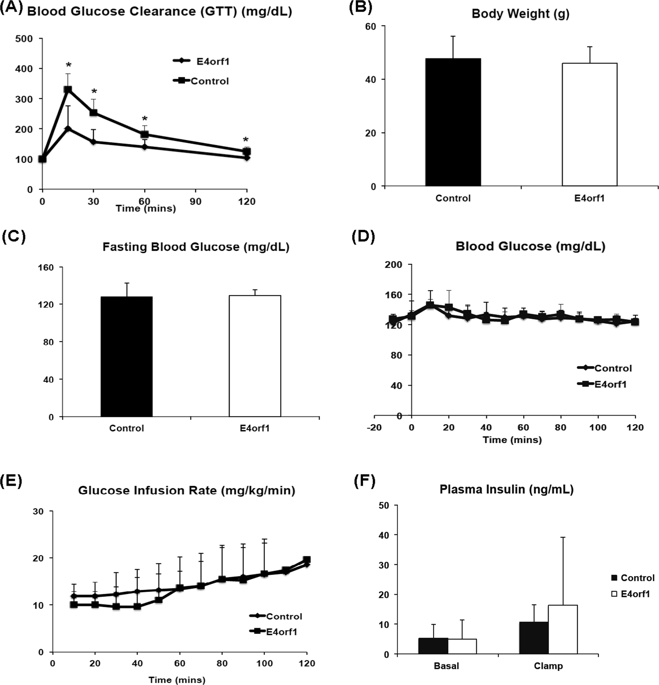当前位置:
X-MOL 学术
›
Nutr. Diabetes
›
论文详情
Our official English website, www.x-mol.net, welcomes your feedback! (Note: you will need to create a separate account there.)
E4orf1 protein reduces the need for endogenous insulin.
Nutrition & Diabetes ( IF 6.1 ) Pub Date : 2019-05-24 , DOI: 10.1038/s41387-019-0085-x Swetha Peddibhotla 1 , Vijay Hegde 1 , Md Akheruzzaman 1 , Nikhil V Dhurandhar 1
Nutrition & Diabetes ( IF 6.1 ) Pub Date : 2019-05-24 , DOI: 10.1038/s41387-019-0085-x Swetha Peddibhotla 1 , Vijay Hegde 1 , Md Akheruzzaman 1 , Nikhil V Dhurandhar 1
Affiliation

|
BACKGROUND
E4orf1 protein derived from adenovirus-36 reduces glucose excursion in mice, and lowers endogenous insulin response, suggesting a reduced need for insulin. We tested if the E4orf1-mediated lowering of insulin response is due to increased tissue sensitivity to insulin, reduced ability to produce or release insulin, or a reduced need for insulin release.
METHODS
Experiment 1: hyperinsulinemic-euglycemic clamps (HEC) and glucose tolerance test (GTT) were performed in high fat fed transgenic mice expressing E4orf1 or non-transgenic littermates (n = 12 each), for 4 weeks. Experiments 2, 3, and 4: E4orf1 or null vectors were expressed in rat-pancreatic β-cell line (INS-1) for 72 h, and cells were exposed to varying levels of glucose. Cell lysates and media were collected. Experiment 5: 3T3L1-preadipocytes that express E4orf1 upon doxycycline induction, or null vector were induced with doxycycline and then exposed to protein transport inhibitor. Supernatant and cell lysate were collected. Experiment 6: 3T3L1-preadipocytes that express E4orf1 upon doxycycline induction, or null vector were co-cultured with INS-1 cells for 24 h. Media was collected.
RESULTS
Experiment 1: E4orf1 transgenic mice cleared glucose faster compared to non-transgenic mice during GTT. HEC showed that E4orf1 did not alter tissue sensitivity to exogenous insulin in mice. Experiments 2, 3, and 4: in INS1 cells, E4orf1 did not alter Glut2 abundance or Akt activation, suggesting no reduction in glucose sensing or insulin synthesis, respectively. E4orf1 did not influence glucose-stimulated insulin secretion in media by INS1 cells. Experiment 5: E4orf1 was present in cell lysate, but not in media, indicating it is not a secretory protein. Experiment 6: INS1 cells released less insulin in media when co-cultured in the presence of E4orf1-expressing 3T3-L1 cells.
CONCLUSIONS
Our studies support the working hypothesis that the E4orf1-mediated lowering of insulin response is not due to increased tissue sensitivity to insulin, or reduced ability to produce or release insulin, but likely to be due to a reduced need for insulin release.
中文翻译:

E4orf1蛋白减少了对内源性胰岛素的需求。
背景技术源自腺病毒36的E4orf1蛋白可降低小鼠的葡萄糖漂移,并降低内源性胰岛素反应,表明对胰岛素的需求减少。我们测试了E4orf1介导的胰岛素反应降低是由于组织对胰岛素的敏感性增加,产生或释放胰岛素的能力降低,还是对胰岛素释放的需求降低。方法实验1:在高脂肪喂养的表达E4orf1或非转基因同窝仔的转基因小鼠(每只n = 12)中进行高胰岛素正常血糖钳(HEC)和葡萄糖耐量试验(GTT),持续4周。实验2、3和4:在大鼠胰腺β细胞系(INS-1)中表达E4orf1或空载体72小时,并将细胞暴露于不同水平的葡萄糖中。收集细胞裂解物和培养基。实验5:用强力霉素诱导在强力霉素诱导后表达E4orf1或无效载体的3T3L1前脂肪细胞,然后暴露于蛋白质转运抑制剂。收集上清液和细胞裂解液。实验6:将在强力霉素诱导下表达E4orf1或无效载体的3T3L1前脂肪细胞与INS-1细胞共培养24小时。媒体被收集。结果实验1:在GTT期间,与非转基因小鼠相比,E4orf1转基因小鼠清除葡萄糖的速度更快。HEC显示E4orf1不会改变小鼠对外源胰岛素的组织敏感性。实验2、3和4:在INS1细胞中,E4orf1不会改变Glut2的丰度或Akt激活,分别提示葡萄糖感应或胰岛素合成没有降低。E4orf1不会影响INS1细胞在培养基中葡萄糖刺激的胰岛素分泌。实验5:E4orf1存在于细胞裂解物中,但不存在于培养基中,表明它不是分泌蛋白。实验6:在表达E4orf1的3T3-L1细胞存在下共培养时,INS1细胞在培养基中释放的胰岛素较少。结论我们的研究支持以下工作假设:E4orf1介导的胰岛素反应降低并非由于组织对胰岛素的敏感性增加或胰岛素产生或释放的能力降低,而可能是由于减少了对胰岛素释放的需求。
更新日期:2019-05-24
中文翻译:

E4orf1蛋白减少了对内源性胰岛素的需求。
背景技术源自腺病毒36的E4orf1蛋白可降低小鼠的葡萄糖漂移,并降低内源性胰岛素反应,表明对胰岛素的需求减少。我们测试了E4orf1介导的胰岛素反应降低是由于组织对胰岛素的敏感性增加,产生或释放胰岛素的能力降低,还是对胰岛素释放的需求降低。方法实验1:在高脂肪喂养的表达E4orf1或非转基因同窝仔的转基因小鼠(每只n = 12)中进行高胰岛素正常血糖钳(HEC)和葡萄糖耐量试验(GTT),持续4周。实验2、3和4:在大鼠胰腺β细胞系(INS-1)中表达E4orf1或空载体72小时,并将细胞暴露于不同水平的葡萄糖中。收集细胞裂解物和培养基。实验5:用强力霉素诱导在强力霉素诱导后表达E4orf1或无效载体的3T3L1前脂肪细胞,然后暴露于蛋白质转运抑制剂。收集上清液和细胞裂解液。实验6:将在强力霉素诱导下表达E4orf1或无效载体的3T3L1前脂肪细胞与INS-1细胞共培养24小时。媒体被收集。结果实验1:在GTT期间,与非转基因小鼠相比,E4orf1转基因小鼠清除葡萄糖的速度更快。HEC显示E4orf1不会改变小鼠对外源胰岛素的组织敏感性。实验2、3和4:在INS1细胞中,E4orf1不会改变Glut2的丰度或Akt激活,分别提示葡萄糖感应或胰岛素合成没有降低。E4orf1不会影响INS1细胞在培养基中葡萄糖刺激的胰岛素分泌。实验5:E4orf1存在于细胞裂解物中,但不存在于培养基中,表明它不是分泌蛋白。实验6:在表达E4orf1的3T3-L1细胞存在下共培养时,INS1细胞在培养基中释放的胰岛素较少。结论我们的研究支持以下工作假设:E4orf1介导的胰岛素反应降低并非由于组织对胰岛素的敏感性增加或胰岛素产生或释放的能力降低,而可能是由于减少了对胰岛素释放的需求。



























 京公网安备 11010802027423号
京公网安备 11010802027423号